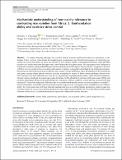| dc.contributor.author | Dorothy A Onyango, Fredrickson Entila, James Egdane, Myrish Pacleb, Meggy Lou Katimbang, Mathew M Dida, Abdelbagi M Ismail, Khady N Drame | |
| dc.date.accessioned | 2020-09-01T06:14:40Z | |
| dc.date.available | 2020-09-01T06:14:40Z | |
| dc.date.issued | 2020-02-03 | |
| dc.identifier.uri | https://repository.maseno.ac.ke/handle/123456789/2628 | |
| dc.description.abstract | To enhance breeding efficiency for iron (Fe) toxicity tolerance and boost lowland rice production in sub-Saharan Africa, we have characterised the morphological, physiological and biochemical responses of contrasting rice varieties to excess iron. Here, we report the capacity of four varieties (CK801 and Suakoko8 (tolerant), Supa and IR64 (sensitive)) to oxidise iron in the rhizosphere and control iron-induced oxidative stress. The experiments were conducted in hydroponic conditions using modified Magnavaca nutrient solution and 300 ppm of ferrous iron (Fe2+) supplied in the form of FeSO4. Severe oxidative stress was observed in sensitive varieties as revealed by their high levels of lipid peroxidation. Histochemical and biochemical analyses showed that tolerant varieties exhibited a better development of the aerenchyma and greater oxygen release than the sensitive varieties in response to excess Fe. Both suberin and lignin deposits were observed in the root, stem and leaf tissues but with varying intensities depending on the variety. Under iron toxic conditions, tolerant varieties displayed increased superoxide dismutase (SOD), glutathione reductase (GR), peroxidase (POX) and ascorbate peroxidase (APX) activities in both the roots and shoots, whereas sensitive varieties showed increased APX and catalase (CAT) activities in the roots. This study had revealed also that Suakoko8 mainly uses root oxidation to exclude Fe2+ from its rhizosphere, and CK801 possesses a strong reactive oxygen species scavenging system, in addition to root oxidation ability. Key traits associated with these tolerance mechanisms such as a well-developed aerenchyma, radial oxygen loss restricted to the root cap as well as strong activation of antioxidative enzymes (SOD, GR, POX and APX) could be useful selection criteria in rice varietal improvement programs for enhanced Fe toxicity tolerance. | en_US |
| dc.publisher | CSIRO PUBLISHING | en_US |
| dc.subject | abiotic stress, aerenchyma, antioxidants, iron oxidation control, radial oxygen loss, rice. | en_US |
| dc.title | Mechanistic understanding of iron toxicity tolerance in contrasting rice varieties from Africa: 2. Root oxidation ability and oxidative stress control | en_US |
| dc.type | Article | en_US |

